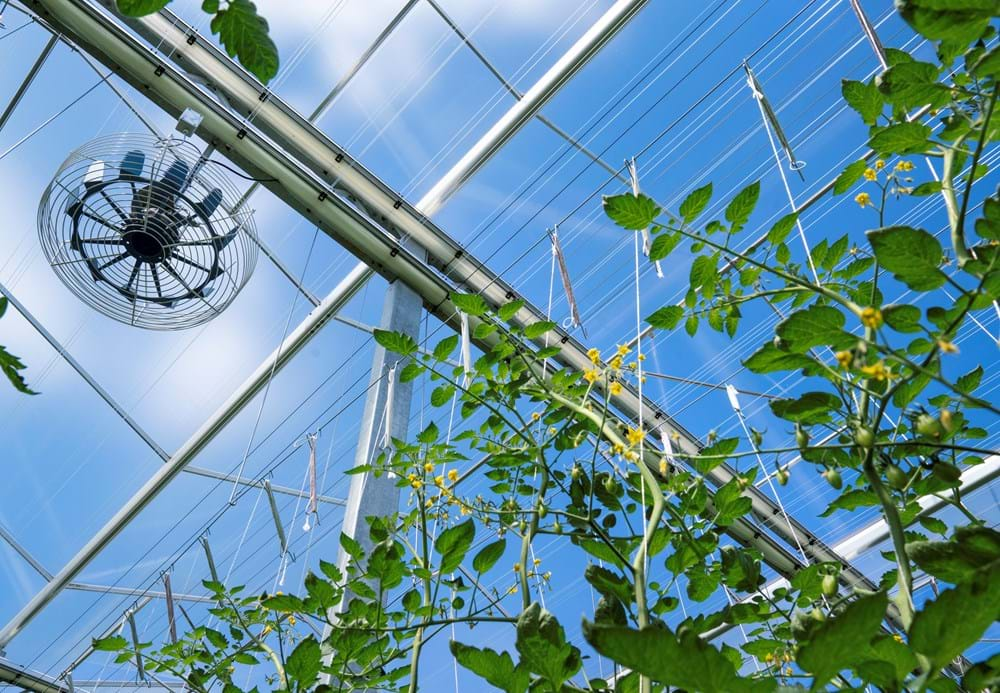Since 2018, there's been a standard that scientifically measures the light properties of screens—NEN 2675:2018. This standard helps accurately determine and compare the light transmission and Hortiscatter of different climate screens. "When you're buying a new screen cloth, make sure to compare the light transmission and Hortiscatter using this standard," advises Svensson Climate Advisor, Joris Vermonden.
Perpendicular light transmission doesn’t provide a full picture of how much light actually reaches the crop, since most light—especially in winter—enters a greenhouse diffusely rather than directly. Light comes in from all directions, making diffuse light transmission the key focus when it comes to greenhouse covering materials and screens. The NEN standard mentioned earlier outlines how to accurately measure both types of light transmission.
Investing in extra light pays off
In greenhouse horticulture, transparent energy-saving climate screens have become widely popular. These screens offer the added benefit of being used during the day to save energy and prevent radiation from the crop. A simple truth applies to these screens: the more light they allow through, the faster the crop grows. This rule of thumb holds true year-round: 1% more light results in 0.8% more growth, and even in the dim winter months, that 1% increase in light still makes a difference.
Diffuse light transmission
A lot of time and attention goes into evaluating the (diffuse) light transmission of the glass used for greenhouse covers, but the same care should be given to selecting the right screen cloth. Joris Vermonden, Climate Advisor at Svensson, encourages growers to always request the diffuse light transmission data according to NEN 2675:2018 when purchasing a screen or to have a sample tested. It’s a worthwhile investment, especially when installing material over dozens of hectares. The cost of a NEN measurement is minimal compared to the light gain you’ll achieve over the years. While not all parties may share these measurements, we make it a point to do so. We believe in being as transparent about the NEN standard as our climate screens are.
Which (double) energy screen
In many crops, using a double energy screen has become the norm, with the highly transparent Luxous 1147 FR from Svensson being a popular choice. However, more growers are now opting for a combination with Luxous 1147 H2no FR. This screen cloth allows condensation droplets to form a film, which results in a 7 to 8% light gain when condensation occurs. “Growers are spending more screen hours during the autumn, winter, and spring. With an actively evaporating crop, moisture from the cultivation space often condenses on the screen. That’s why we’re seeing an increasing number of growers investing in Luxous 1147 H2no FR. It allows them to maximize light transmission even with extended screen use during the day or when working with a lower moisture deficit,” explains a Svensson representative.

Energy savings plus dehumidification
One of the key benefits of the energy screen mentioned above is its moisture permeability, allowing moisture to be released. This effect can be enhanced by ventilating on the same side above a closed screen. However, with a double screen, moisture exchange naturally decreases, which can temporarily lead to excessively high humidity when crop evaporation is high and the weather is mild. In such cases, leaving a gap in the screen becomes necessary, but this can create horizontal temperature differences within the section. To avoid this, many growers opt for a dehumidification system that eliminates the need for gaps and maintains a consistent greenhouse climate. A great example of such a system is ClimaFlow, a vertical ventilation system that uses Ventilationjets to blow dry air from above the screen into the greenhouse. This air is then mixed with the greenhouse air below the screen by vertical ClimaFlow fans placed under the jet. This system is characterized by improved air circulation and distribution throughout the crop, effectively preventing moisture-related issues. Additionally, its low power consumption makes it an extremely energy-efficient solution for dehumidification.
Improved light quantity and quality
When evaluating screens, it's not just the quantity of light they let through that matters—quality aspects are important too. Beyond the light spectrum, it's crucial to consider how well the incoming light is diffused. A simple principle applies here: the more diffuse the light, the better the plants grow. Joris explains, “Diffuse light is distributed more evenly over all leaves and penetrates deeper into the crop. This means more leaves can participate in photosynthesis, as research from WUR has shown.”
The materials used for greenhouse covers and climate screens play a significant role in this. Some materials allow light to pass through effectively, while others excel at spreading the light, making it more diffuse. The Hortiscatter value, which ranges from 0 to 100%, indicates how well the light is distributed—the higher the percentage, the better the light distribution. Joris adds, “WUR research found that under the same conditions, a 10% increase in Hortiscatter can boost crop growth and production by 2 to 8%, depending on the cultivation. So, it’s definitely worth considering this when choosing a climate screen.”
The NEN standard outlines how to determine this value, ensuring a fair comparison between glass and screens.
Sun protection and Hortiscatter
For a climate screen designed mainly for energy savings, the (diffuse) light transmission is crucial. On the other hand, if the screen’s primary purpose is sun protection, the Hortiscatter becomes particularly important. Sun protection is needed when the sun is shining brightly, with a lot of direct light. A Harmony screen excels in this regard by providing high-quality diffuse light. It’s a win-win: the intense sunlight is softened and converted into diffuse light, which means the plant benefits greatly from what remains.
For more information, please contact the climate advisor
Joris Vermonden
joris.vermonden@ludvigsvensson.com
+ 31 6 21 17 84 58